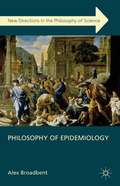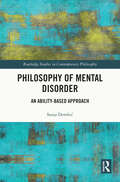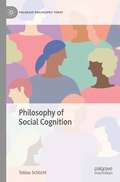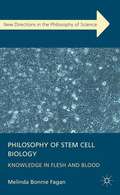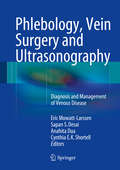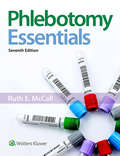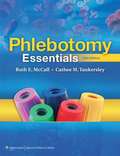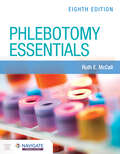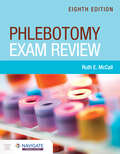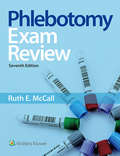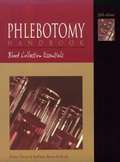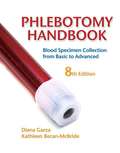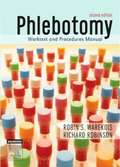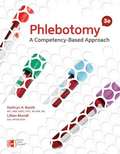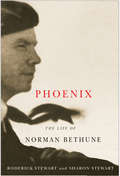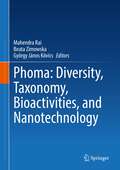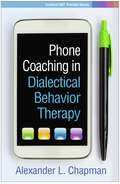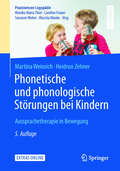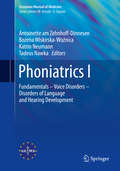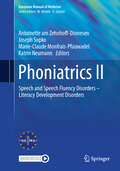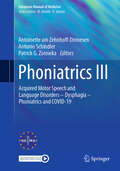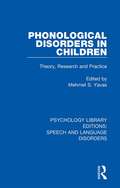- Table View
- List View
Philosophy of Epidemiology
by Alex BroadbentEpidemiology is one of the fastest growing and increasingly important sciences. This thorough analysis lays out the conceptual foundations of epidemiology, identifying traps and setting out the benefits of properly understanding this fascinating and important discipline, as well as providing the means to do so.
Philosophy of Mental Disorder: An Ability-Based Approach (Routledge Studies in Contemporary Philosophy)
by Sanja DembićThis book offers an ability-based view of mental disorders. It develops a detailed analysis of the concept of inability that is relevant in the psychiatric and psychotherapeutic context by drawing on the most recent literature on the concepts of ability, reasons, and harm. What is it to have a mental disorder? This book contends that an individual has a mental disorder if and only if (1) they are・in the relevant sense・unable to respond adequately to their available (apparent) reasons in their thinking, feeling, or acting, and (2) they are harmed by the condition underlying or resulting from that inability. The author calls this the “Rehability View.” This view can account for what is “mental” about mental disorders: it is the rational relations among an individual’s attitudes and actions that are “disordered,” and the relevant norms are the norms of reasons. This view is compatible with explanations of mental disorders in terms of biological dysfunctions, without reducing the former to the latter. The aim is not to offer just another conception of mental disorder, but to develop a systematic approach that incorporates insights from the philosophy of psychiatry and adjacent philosophical disciplines. Philosophy of Mental Disorder will be of interest to scholars and advanced students working in philosophy of psychiatry, philosophy of mind, philosophy of action, ethics, and mental health.
Philosophy of Social Cognition (Palgrave Philosophy Today)
by Tobias SchlichtThis introductory textbook provides a comprehensive and up-to-date overview of the main issues in contemporary philosophy of social cognition. It explains and critically discusses each of the key philosophical answers to the captivating question of how we understand the mental life of other sentient creatures. Key Features:· Clearly and fully describes the major theoretical approaches to the understanding of other people’s minds.· Suggests the major advantages and limitations of each approach, indicating how they differ as well as the ideas they have in common. · Tests each philosophical theory against the best available empirical data from psychology, neuroscience and psychopathology.· Includes suggestions for additional reading and practice study questions at the end of each chapter. Philosophy of Social Cognition is essential reading for all undergraduate and graduate students taking introductory courses on social cognition. It is also ideal for courses on cognitive neuroscience, social psychology and sociological theory.
Philosophy of Stem Cell Biology
by Melinda Bonnie FaganThis examination of stem cell biology from a philosophy of science perspective clarifies the field's central concept, the stem cell, as well as its aims, methods, models, explanations and evidential challenges. Relations to systems biology and clinical medicine are also discussed.
Phlebology, Vein Surgery and Ultrasonography
by Anahita Dua Sapan S. Desai Eric Mowatt-Larssen Cynthia E. K. ShortellThis comprehensive, up-to-date textbook offers detailed coverage of venous anatomy, pathophysiology, imaging, and management of venous pathology, leading the practitioner through all aspects of care of the venous patient. The various techniques that have revolutionized the diagnosis and treatment of venous disease during the past decade are all discussed, with clear guidance on their indications and performance. The book is exceptional in being based entirely on the curriculum designed for board certification by the American College of Phlebology. A further unique aspect of the text is the integration of ultrasound, which now plays a fundamental role in diagnosis and management. The authors come from a wide range of specialties and the book will accordingly serve the needs of vascular and general surgeons, interventional radiologists, phlebologists, ultrasonographers, and other practitioners, as well as those preparing for board examinations.
Phlebotomy Essentials
by Ruth McCallEnsure a confident transition from classroom to clinic with this proven, approachable phlebotomy resource. Phlebotomy Essentials, Seventh Edition easily instills the core knowledge and clinical understanding behind safe, effective patient communication and interaction. Enhanced with new images, a more efficient design, and new contributions from leading subject matter experts, this updated edition details how today’s phlebotomists work in an approach optimized for how today’s students learn. Combined with an optional Workbook, Exam Review book, and updated PrepU adaptive quizzing software, the latest edition of Phlebotomy Essentials represents a cornerstone of preparation for a successful career in phlebotomy.
Phlebotomy Essentials (4th Edition)
by Ruth E. Mccall Cathee M. TankersleyThe text provides accurate, practical information and instruction on phlebotomy procedures with a comprehensive background in theory and principles. Reflecting current CLSI guidelines, NAACLS competencies, and federal regulations, this Fourth Edition includes updated information on safety issues and equipment, laboratory information systems and instrumentation, legal issues, and diagnostic tests. This edition also includes caution notes identifying dangerous practices and problem areas.
Phlebotomy Essentials with Navigate Premier Access
by Ruth E. McCallPhlebotomy Essentials, Eighth Edition provides accurate, up-to-date, and practical information and instruction in phlebotomy procedures and techniques, along with a comprehensive background in phlebotomy theory and principles. It is appropriate for use as an instructional text or as a reference for those who wish to update skills or study for national certification. Enhanced with new images, a more efficient design, and new contributions from leading subject matter experts, this updated edition details how today's phlebotomists work in an approach optimized for how today's students learn. Combined with an optional Workbook, Exam Review book, and updated digital courseware, the latest edition of Phlebotomy Essentials represents a cornerstone of preparation for a successful career in phlebotomy.
Phlebotomy Exam Review
by Ruth E. McCallPhlebotomy Exam Review, Eighth Edition provides a comprehensive review of current phlebotomy theory and offers and ideal way to study for phlebotomy licensing or national certification exams. It also makes for an excellent study tool for students taking formal phlebotomy training programs.By answering the questions in this review, student can test their knowledge and application of current phlebotomy theory. Theory questions address recent federal safety standards, Clinical and Laboratory Standards Institute (CLSI) guidelines, and the National Accrediting Agency for Clinical Laboratory Sciences (NAACLS) phlebotomist competencies when applicable. Questions are standard multiple choice, like those used on national exams, with choices that often test your critical thinking abilities. © 2024 | 380 pages
Phlebotomy Exam Review
by Ruth McCallPhlebotomy Exam Review thoroughly prepares students for any of the national certification exams. This product follows the latest accreditation guidelines with questions following current safety standards and accrediting competencies. Questions sections in this book follows the same chapter organization as the textbook, Phlebotomy Essentials , Seventh edition, making it an ideal study companion.
Phlebotomy Handbook: Blood Collection Essentials (Fifth Edition)
by Diana Garza Kathleen Becan-McbrideFor medical lab technology, medical assisting, respiratory therapy, radiological technology, and nursing courses. This leading text is the most accurate and current source of blood and specimen collection information for today's health care students and professionals. Designed to provide health care professionals with the clinical, technical, and communication skills and knowledge, it features sections devoted to safety; equipment and collection; special procedures and point of care testing; and quality and legal issues.
Phlebotomy Handbook: Blood Collection Essentials (fifth edition)
by Diana Garza Kathleen Becan-McbrideFor medical lab technology, medical assisting, respiratory therapy, radiological technology, and nursing courses. This leading text is the most accurate and current source of blood and specimen collection information for today's health care students and professionals. Designed to provide health care professionals with the clinical, technical, and communication skills and knowledge, it features sections devoted to safety; equipment and collection; special procedures and point of care testing; and quality and legal issues.
Phlebotomy Handbook: Blood Specimen Collection from Basic to Advanced (Eighth Edition)
by Diana Garza Kathleen Becan-McbrideThe 'Phlebotomy Handbook' is a comprehensive book covering blood and specimen collection. This eighth edition provides health care professionals with updated safety guidelines; condensed information about federal regulations; updates on equipment and supplies; new NCCLS standards and hazard prevention techniques; competencies important in the workplace; strategies for the certification process and securing a job; and extensive coverage on transcultural communication skills for all ages.
Phlebotomy Worktext and Procedure Manual (Second Edition)
by Richard Robinson Robin S. WarekoisThe book provides a complete introduction to the practice of phlebotomy in all its aspects.
Phlebotomy: A Competency-Based Approach
by Kathryn Booth Fitzgerald Lillian MundtThe third edition of Phlebotomy: A Competency-Based Approach was designed to provide a complete introduction to the practice of phlebotomy, with complete coverage of safety procedures, equipment, point-of-care testing, and other skills. The textbook speaks directly to students and encourages them to identify and apply the concepts learned. The text focuses on "need-to-know" information, and explains the reasoning behind the clinical information for a well-rounded and practical learning experience. It is suitable for phlebotomy certification programs, medical laboratory technician programs, medical assistant programs, and even independent and distance learning courses.
Phlebotomy: Worktext and Procedures Manual
by Richard Robinson Robin S. Warekois Pamela PrimroseMaster practical phlebotomy skills with Phlebotomy: Worktext and Procedures Manual, 5th Edition! Known for its storyboard format of procedures and beautiful illustrations, this hands-on worktext describes all aspects of phlebotomy ― with focused and current coverage of lab tests, equipment, safety and collection procedures, emergency situations, special populations, and point-of-care testing. <p><p>Procedures, outlined with step-by-step instructions and full-color photos, cover core competencies; and a detachable bookmark with color tube guide acts as a handy clinical reference. Learning features focus on clinical scenarios, practice tips, and error prevention and are supplemented by videos and certification exam preparation.
Phoenix
by Sharon Stewart Roderick StewartIn Phoenix: The Life of Norman Bethune Roderick and Sharon Stewart provide the intriguing details of Bethune's controversial career as a surgeon, his turbulent personal life, his passionate crusade to eradicate tuberculosis, and his pioneering commitment to the establishment of medicare in Canada. They also examine the reasoning that led Bethune to embrace Marxism and show the depth of his faith in the triumph of communism over fascism - a commitment that drove him to take risk after risk and ultimately led to his death from an infection caught while performing battlefield surgery in remote northern China. Based on extensive research in Canada, Spain, and China, and in-depth interviews with Bethune's family, friends, colleagues, and patients, Phoenix: The Life of Norman Bethune is the definitive Bethune biography for our time.
Phoenix: The Life of Norman Bethune
by Sharon Stewart Roderick StewartRestless, dynamic, conflicted, a surgeon, an artist, and a writer, Norman Bethune was an extraordinary Canadian. Brilliant, yet erratic, Bethune's life was characterized by cycles of achievement and self-destruction and his adventurous spirit led him from the operating rooms of Montreal to the battlegrounds of Spain and China. In Phoenix: The Life of Norman Bethune Roderick and Sharon Stewart provide the intriguing details of Bethune's controversial career as a surgeon, his turbulent personal life, his passionate crusade to eradicate tuberculosis, and his pioneering commitment to the establishment of medicare in Canada. They also examine the reasoning that led Bethune to embrace Marxism and show the depth of his faith in the triumph of communism over fascism - a commitment that drove him to take risk after risk and ultimately led to his death from an infection caught while performing battlefield surgery in remote northern China. Based on extensive research in Canada, Spain, and China, and in-depth interviews with Bethune's family, friends, colleagues, and patients, Phoenix: The Life of Norman Bethune is the definitive Bethune biography for our time.
Phoma: Diversity, Taxonomy, Bioactivities, and Nanotechnology
by Mahendra Rai Beata Zimowska György János KövicsThe book covers the taxonomy, diversity, bioactivity, and nanotechnology involved in the study of the genus Phoma. It presents the most recent molecular taxonomic approach, secondary metabolites, different bioactivities, combating microbial threats, and its use in nanotechnology from a basic research to an applied perspective. Expert contributors provide the latest research and applications to present thorough coverage of this important genus in human and plant pathology and the disease management.
Phone Coaching in Dialectical Behavior Therapy (Guilford DBT® Practice Series)
by Alexander L. ChapmanThis is the first comprehensive guide to phone coaching in dialectical behavior therapy (DBT)--an integral part of treatment that many clinicians find challenging. What are the principles and goals of phone coaching? What limits should be set? How can a therapist manage suicide risk during a brief call? DBT expert Alexander Chapman addresses these and other critical practical questions in this accessible book. He provides guidelines for coaching core DBT distress tolerance and emotion regulation skills; coaching "dos and don'ts"; and tips for structuring each call's beginning, middle, and end. Featuring many concrete examples, strategies, and model dialogues, the book includes a key chapter on suicide crisis calls.
Phonetische und phonologische Störungen bei Kindern
by Martina Weinrich Heidrun ZehnerDieses Lehrbuch bietet im Bereich der Kindersprache tätigen Logopäden umfassendes Praxiswissen zur Diagnostik und Therapie kindlicher Aussprachestörungen. Die erfahrenen Autorinnen vermitteln kompakt die Grundlagen zu Phonetik und Phonologie sowie zum physiologischen Lauterwerb und erläutern die genaue Befunderhebung auch unter Aspekten von ICF. Sie stellen bewährte Therapiemethoden vor und zeigen das konkrete Vorgehen in der individuellen Therapiegestaltung. Profitieren Sie von zahlreichen praktischen Anregungen und Spielideen zur Lautbildung und –Verwendung. So gelingt die vielfältige und erfolgreiche Behandlung von Aussprachestörungen, die gleichzeitig die Sprachverarbeitungsfähigkeiten des Kindes miteinbezieht.
Phoniatrics I: Fundamentals – Voice Disorders – Disorders of Language and Hearing Development (European Manual of Medicine)
by Katrin Neumann Antoinette am Zehnhoff-Dinnesen Bożena Wiskirska-Woźnica Tadeus NawkaThis is the first of two volumes that draw on the specialized insights and extensive clinical experience of phoniatric experts in order to offer a basis for the development of concerted European training standards in phoniatrics, with the goal of guaranteeing a high quality of care for European patients in all age groups. The interdisciplinary character of phoniatrics is mirrored in the inclusion of valuable contributions from a range of other medical and non-medical disciplines. This volume focuses on voice disorders and disorders of language and hearing development. In each case a wide range of particular kinds of communication loss are considered. Basic aspects are fully addressed, and guidance provided on diagnostic methods, differential diagnosis, prevention, treatment/rehabilitation, and prognosis. An introductory section also discusses the fundamentals of phoniatrics. The reader will benefit from numerous color photos and tables as well as supplementary electronic material, including audio and video examples. This book is intended for residents and practitioners in phoniatrics and also for ENT physicians, medical students, logopedists, and speech and language pathologists and therapists.
Phoniatrics II: Speech and Speech Fluency Disorders – Literacy Development Disorders (European Manual of Medicine)
by Katrin Neumann Antoinette am Zehnhoff-Dinnesen Joseph Sopko Marie - Claude Monfrais-PfauwadelThis book, in three volumes, draws on the specialized insights and extensive clinical experience of phoniatric experts to offer a basis for the development of concerted European training standards, with the goal of guaranteeing a high quality of phoniatric care for all European patients. Communication disorders in all age groups are covered, and the interdisciplinary character of phoniatrics is mirrored in the inclusion of contributions from a range of other medical and non-medical disciplines. This second volume is devoted to speech, speech fluency and literacy development disorders. Basic aspects, including etiology and pathogenesis, are fully addressed, and guidance provided on diagnostic methods, differential diagnosis, prevention, treatment/rehabilitation, and prognosis. The reader will benefit from numerous color photos, tables as well as supplementary electronic material, including audio and video examples. This book is intended for residents and practitioners in phoniatricsand also for ENT physicians, medical students, logopedists, and speech and language pathologists and therapists.
Phoniatrics III: Acquired Motor Speech and Language Disorders – Dysphagia – Phoniatrics and COVID-19 (European Manual of Medicine)
by Antoinette am Zehnhoff-Dinnesen Antonio Schindler Patrick G. ZorowkaThis book series, in three volumes, draws on the specialized insights and extensive clinical experience of phoniatric experts to offer a basis for the development of concerted European training standards, with the goal of guaranteeing a high quality of phoniatric care for all European patients. Communication disorders in all age groups are covered, and the interdisciplinary character of phoniatrics is mirrored in the inclusion of contributions from a range of other medical and non-medical disciplines. This third volume is devoted to acquired motor speech and language disorders (dysarthria, dyspraxia, and aphasia), swallowing disorders, and phoniatric aspects in treatment of COVID-19 infections. Basic aspects, including etiology and pathogenesis, are fully addressed, and guidance provided on diagnostic methods, differential diagnosis, prevention, treatment/rehabilitation, and prognosis. The reader will benefit from numerous color photos, tables as well as supplementary electronic material, including audio and video examples. This book is intended for residents and practitioners in phoniatrics and also for ENT physicians, medical students, logopedists, and speech and language pathologists and therapists.
Phonological Disorders in Children: Theory, Research and Practice (Psychology Library Editions: Speech and Language Disorders)
by Mehmet S. YavasOriginally published in 1991, the recent developments in the study of phonological disorders in children had led to a fruitful interaction between speech pathology and phonology. It is one aspect of the application of linguistic theory to the study of speech and language disorders which had opened up a new field, clinical linguistics. This book brings together the concerns of the linguist and the speech pathologist; the essays chosen share the quality of not discussing theory or therapy without addressing the implications one has for the other. By concentrating on recent work the editor hoped to stimulate further discussion in this important and fast growing area of research.
